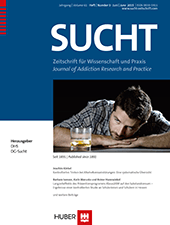Langzeiteffekte des Präventionsprogramms Klasse2000 auf den Substanzkonsum
Ergebnisse einer kontrollierten Studie an Schülerinnen und Schülern in Hessen
Abstract
Zielsetzung: Untersuchung der langfristigen Auswirkungen des für die Grundschule konzipierten Präventionsprogramms Klasse2000 auf den Substanzkonsum. Methodik: Klasse2000 will mittels interaktiver Methoden die Lebenskompetenzen fördern und zu einem gesunden Lebensstil motivieren. Die Daten wurden in schriftlichen Nachbefragungen einer Kontrollgruppenstudie mit Messwiederholung 16 Monate (N = 501, mittl. Alter 11,4 Jahre, 43,7 % männlich) und 36 Monate (N = 408, mittl. Alter 12,9 Jahre, 43,1 % männlich) nach Ende der Intervention gewonnen. Die Zuteilung zu den Gruppen erfolgte in der Ursprungsstudie auf Ebene der Schulen unter Berücksichtigung der Präferenz der Schulen. Ergebnisse: In beiden Nachbefragungen waren Lebenszeitprävalenz und Inzidenz des Rauchens in der Interventionsgruppe statistisch bedeutsam geringer als in der Kontrollgruppe. Beim Alkoholkonsum konnte nur in der ersten Nachbefragung eine signifikant geringere Lebenszeitprävalenz in der Interventionsgruppe gefunden werden. In der zweiten Nachbefragung war in der Untergruppe derjenigen Jugendlichen, die bereits Alkohol konsumiert hatten, in der Interventionsgruppe die Intensität des Alkoholkonsums geringer als in der Kontrollgruppe. Schlussfolgerungen: 16 bzw. 36 Monate nach Abschluss der Intervention finden sich Hinweise auf präventive Effekte des Programms Klasse2000 auf das Rauchverhalten. Für den Alkoholkonsum ist die Befundlage weniger überzeugend.
Aims: To investigate the long-term effects of the elementary school-based prevention program Klasse2000 on substance use. Methods: Klasse2000 is a curriculum for grades 1 to 4 which is implemented in routine school settings. By using interactive methods, Klasse2000 aims to foster life skills as well as a healthy lifestyle in children. Data were assessed in two written follow-up surveys of a sample of students originating from a controlled trial in Hesse. Surveys were conducted 16 months (N = 501, mean age 11.4 years, 43.7 % male) and 36 months (N = 408, mean age 12.9 years, 43.1 % male) after the completion of the intervention. In the origin study, schools were allocated to either the intervention or control group, the preference of schools being taken into account. Results: In both follow-up surveys, lifetime prevalence and incidence of smoking was significantly lower in intervention students compared to control students. There was only one significant group difference for lifetime prevalence of alcohol use in the first follow-up survey. At second follow-up, intensity of alcohol use among those with ever-use was lower in intervention students. Conclusion: We found hints for the preventive effects of Klasse2000 on smoking 16 resp. 36 months after completion of the intervention. For alcohol use, the evidence of efficacy is less convincing.
Literatur
(1997). Suchtprävention an Schulen – Besondere Aspekte des Nikotinabusus: Effekte nach einer vierjährigen Intervention durch das Suchtpräventions- und Gesundheitsförderungsprogramm Klasse2000. Prävention und Rehabilitation, 9, 82 – 88.
(2009). Origin and use of the 100 cigarette criterion in tobacco surveys. Tobacco Control, 18(4), 317 – 323.
(2009). Introduction to meta-analysis. Chichester: John Wiley & Sons.
(2000). Preventing drug abuse in schools: social and competence enhancement approaches targeting individual-level etiologic factors. Addictive Behaviors, 25, 887 – 897.
(1990). Preventing adolescent drug abuse through a multimodal cognitive-behavioral approach: results of a 3-year study. Journal of Consulting and Clinical Psychology, 58, 437 – 446.
(1988). Statistical power analyses for behavioral science. Hilldale, New York: Erlbaum.
(2002). Effective ingredients of school-based drug prevention programs. A systematic review. Addictive Behaviors, 27, 1009 – 1023.
(1994). How effective is drug abuse resistance education? A meta-analysis of Project DARE outcome evaluations. American Journal of Public Health, 84, 1394 – 1401.
(1976). Smoking in children: developing a social psychological strategy of deterrence. Preventive Medicine, 51, 122 – 127.
(2009a). School-based smoking prevention programs with the promise of long-term effects. Tobacco Induced Diseases, 5, 6.
(2009b). The promise of long-term effectiveness of school-based smoking prevention programs: a critical review of reviews. Tobacco Induced Diseases, 5, 7.
(2002). Primary prevention for alcohol misuse in young people. Cochrane Database of Systematic Reviews, CD003024.
(2011). Universal school-based prevention programs for alcohol misuse in young people. Cochrane Database of Systematic Reviews, CD009113.
(2007). Testing anonymous link procedures for follow-up of adolescents in a school-based trial: The EU-DAP pilot study. Preventive Medicine, 44, 174 – 177.
(2014). Short-term mediating factors of a school-based intervention to prevent youth substance use in Europe. Journal of Adolescent Health, 54, 565 – 573.
(2004). A meta-analysis of adolescent psychosocial smoking prevention programs published between 1978 and 1997 in the United States. Health Education & Behavior, 31, 702 – 719.
(2009). Klasse2000: Evaluation des Unterrichtsprogramms in Hessen. Abschlussbericht. Kiel: Institut für Therapie- und Gesundheitsforschung, IFT-Nord.
(2014). Effects of a school-based prevention programme on smoking in early adolescence: a 6-month follow-up of the Eigenständig werden cluster randomised trial. BMJ Open, 4, e004422.
(2007). Die Europäische Schülerstudie zu Alkohol und anderen Drogen 2007 (ESPAD): Befragung von Schülerinnen und Schülern der 9. und 10. Klasse in Bayern, Berlin, Brandenburg, Hessen, Mecklenburg-Vorpommern, Saarland und Thüringen. München: IFT Institut für Therapieforschung.
(2008). Europäische Schülerstudie zu Alkohol und anderen Drogen 2007 (ESPAD). Befragung von Schülerinnen und Schülern der 9. und 10. Klasse in Bayern, Berlin, Brandenburg, Hessen, Mecklenburg-Vorpommern, Saarland und Thüringen. Institut für Therapieforschung, IFT München.
(2011). Universelle Prävention des Substanzkonsums: Effekte des Grundschulprogramms Klasse2000. Sucht, 57, 301 – 312.
(2005). Mediation analysis of a school-based drug prevention program: effects of Project ALERT. Prevention Science, 6, 35 – 46.
(2013). Stata Statistical Software: Release 13. College Stations, Texas: StataCorp LP.
(2010). Theoretischer Hintergrund und Evaluationsergebnisse. Nürnberg: Verein Klasse2000 e.V.
(2013). School-based programmes for preventing smoking. Cochrane Database of Systematic Reviews, 4, CD001293.
(2000). School-based adolescent drug prevention programs: 1998 meta-analysis. The Journal of Primary Prevention, 20, 275 – 336.
(1997). Effectiveness of school-based drug prevention programs: a meta-analysis of the research. The Journal of Primary Prevention, 18, 71 – 128.



